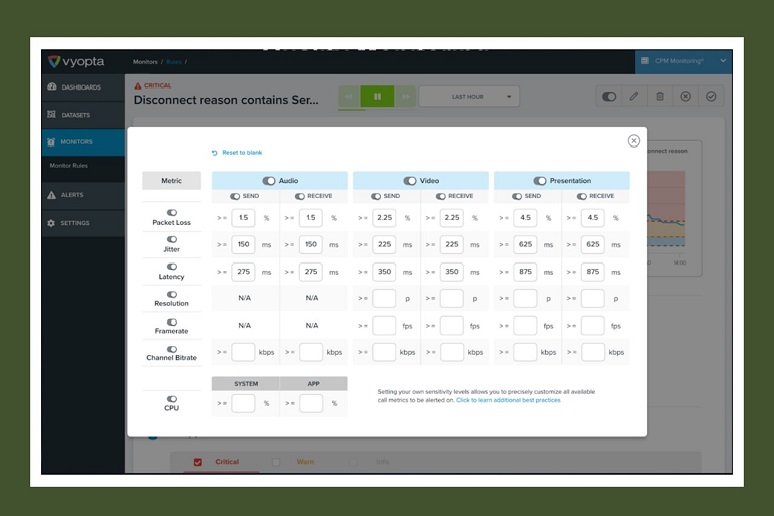UCC monitoring and analytics provider
Vyopta last week announced that it has bulked up its collaboration performance management (CPM) suite with advanced digital experience monitoring capabilities aimed at helping UC architects and UC engineers identify and resolve collaboration issues in real-time, whether those relate to a single meeting, call, or endpoint.
As Terry Slattery, a principal architect with NetCraftsmen, mentioned in a recent
No Jitter article, digital experience monitoring is gaining traction for its “top down approach” to network monitoring and insight it provides into how networks and applications are functioning. With a focus on collaboration, Vyopta approaches experience monitoring by collecting data from on-premises or cloud-based UC applications, like Microsoft Teams and Cisco UCM, and endpoints, like conference room devices or remote worker laptops, and then feeding that data into its CPM platform, Jonathan Sass, VP of product at Vyopta, shared during a No Jitter briefing.
These new experience monitoring capabilities work in tandem with Vyopta's monitoring engine to determine whether the collaboration experience is good, fair, or bad, and discover whether the issue lies with the application, device, or the network. Are CPU spikes causing issues? Are the problems coming from the enterprise network? Is the source of the trouble from external sources?
Using Vyopta’s analytics tools, UC architects and UC engineers can investigate down to an individual user, Sass said. For example, they may want to monitor the collaboration experiences of executives or other users in key roles to make sure degradation doesn’t impact them, Vyopta said. Experience monitoring is helpful in contact center environments, too, Sass noted. With the tool, UC architects and UC engineers should be able to tell why a contact center agent working from home is experiencing problems — maybe the network connection is poor, they don’t have a sufficient link speed, they have one too many tabs open on their laptop, or their headset isn’t compatible with the contact center software. IT can then upgrade the network gear, provide a new headset, or switch ISPs.
In addition, UC architects and UC engineers can look at the data in aggregate. Vyopta recognizes it may be hard, especially in a large enterprise, for someone to monitor every call and issue that takes place, Sass said.
Advanced Experience Monitoring is providing value across verticals, including education and healthcare, Sass noted. As an example, he pointed to the University of Virginia Center for Telehealth, which performs stroke diagnosis via videoconferencing. Proactive alerts and access to real-time quality metrics allow them to identify and resolve issues before they disrupt an emergency clinical session, he said.
Looking at Vyopta’s roadmap, Sass said the company continues to invest heavily in its monitoring engine and expects to release additional capabilities in the third quarter. The company is also focusing on expanding its coverage in the UCaaS space, particularly in the voice segment. Whether the voice infrastructure is on premises or in the cloud, “we are continuing to add additional vendors and products that support a single pane of glass.”










